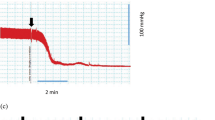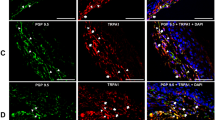Abstract
THE first demonstration of pressure reversal of anaesthesia in amphibians was provided by the tadpole experiments of Johnson and Flagler1 with ethanol and ethyl carbamate. Since then the phenomenon has been studied using general anaesthetics in newts, mice and marine organisms2,3, but few of these agents have been studied in detail and the results in some cases, for example, for barbiturates4,5, are conflicting. Another aspect of the interaction of pressure and anaesthesia is the amelioration of the high pressure nervous syndrome by nitrous oxide, hydrogen or nitrogen6–8. It is not, however, known if other agents can also give ‘pressure protection’, and tadpoles provide a relatively easy model for a preliminary screening of potentially suitable drugs. We have studied both these aspects of the interaction between pressure and narcosis using intravenous, local and inhalational general anaesthetics and tranquillisers. We show that pressure reversal occurred with all our agents producing narcosis in tadpoles, whereas pressure protection does not seem to be as universal.
This is a preview of subscription content, access via your institution
Access options
Subscribe to this journal
Receive 51 print issues and online access
$199.00 per year
only $3.90 per issue
Buy this article
- Purchase on Springer Link
- Instant access to full article PDF
Prices may be subject to local taxes which are calculated during checkout
Similar content being viewed by others
References
Johnson, F. H., and Flagler, E. A., Science, 112, 91–92 (1950); J. cell. comp. Physiol., 37, 15–25 (1951).
Miller, K. W., Paton, W. D. M., Smith, R. A., and Smith, E. B., Molec. Pharmac., 9, 131–143 (1973).
Halsey, M. J., Eger, E. I., Kent, D. W., and Warne, P. J., Progr. Anesthesiol., 1, 353–361 (1975).
Lever, M. J., Miller, K. W., Paton, W. D. M., and Smith, E. B., Nature, 231, 368–371 (1971).
Roth, S. H., Prog. Anesthesiol., 1, 405–420 (1975).
Halsey, M. J., Kent, D. W., and Eger, E. I., Proc. fifth Symp. Underwater Physiol. (in the press).
Brauer, R. W., Goldman, S. M., Beaver, R. W., and Sheenan, M. E., Undersea biomed. Res., 1, 59–72 (1974).
Bennett, P. B., Blenkarn, G. D., Roly, J., and Youngblood, D., Undersea biomed. Res., 1, 221–238 (1975).
Masterton, W. L., J. chem. Phys., 22, 1830–1833 (1954).
Ritchie, J. M., Br. J. Anaesth., 47, 191–198 (1975).
de Jong, R. H., and Eger, E. I., Anesthesiology, 42, 384–389 (1975).
Molecular Mechanisms in General Anaesthesia (edit. by Halsey, M. J., Millar, R. A., and Sutton, J. A.), 47 (Churchill Livingstone, Edinburgh, 1974).
Author information
Authors and Affiliations
Rights and permissions
About this article
Cite this article
HALSEY, M., WARDLEY-SMITH, B. Pressure reversal of narcosis produced by anaesthetics, narcotics and tranquillisers. Nature 257, 811–813 (1975). https://doi.org/10.1038/257811a0
Received:
Accepted:
Issue Date:
DOI: https://doi.org/10.1038/257811a0
This article is cited by
-
High-pressure crystallography shows noble gas intervention into protein-lipid interaction and suggests a model for anaesthetic action
Communications Biology (2022)
-
A pressure-reversible cellular mechanism of general anesthetics capable of altering a possible mechanism for consciousness
SpringerPlus (2015)
-
Investigations into pharmacological antagonism of general anaesthesia
British Journal of Pharmacology (2000)
-
Hyperbaric pressure does not affect the analgesia produced by nitrous oxide in the mouse
Canadian Journal of Anaesthesia (1989)
Comments
By submitting a comment you agree to abide by our Terms and Community Guidelines. If you find something abusive or that does not comply with our terms or guidelines please flag it as inappropriate.



